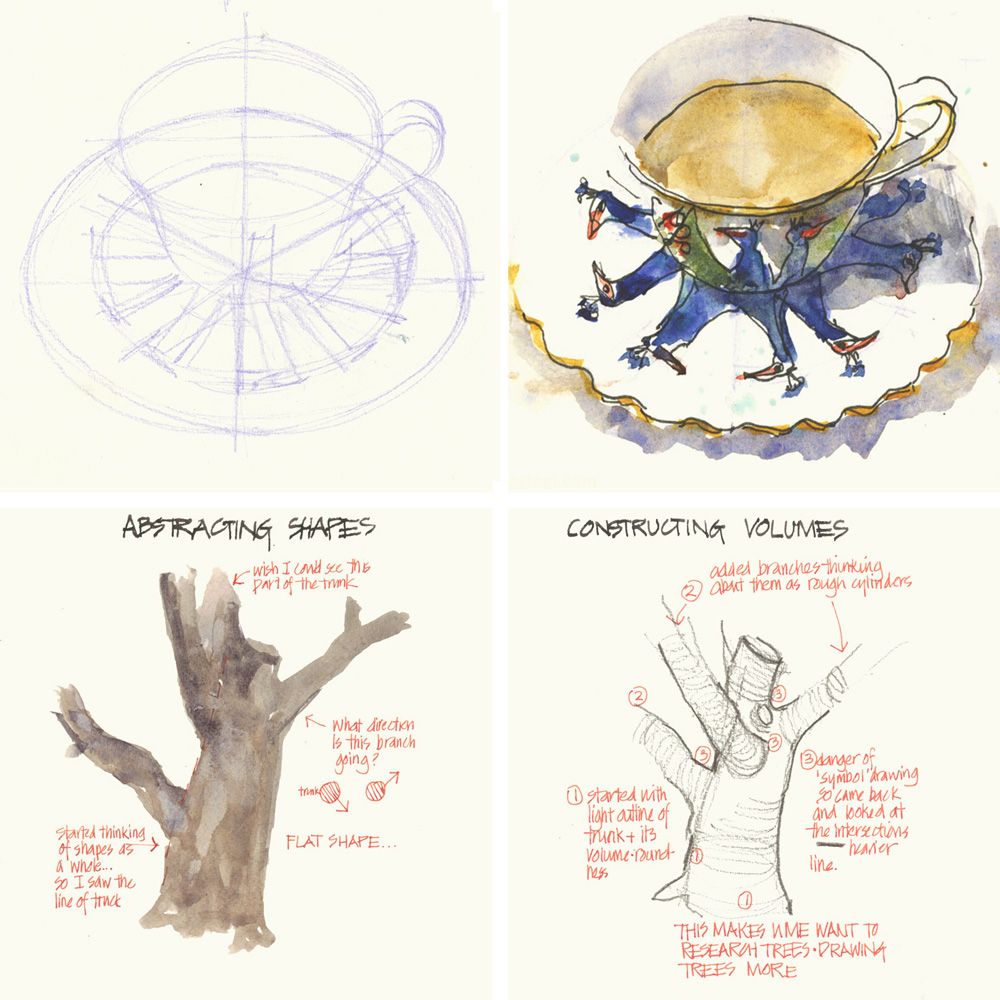
This week I have been thinking about the third way of visual thinking that I explain in detail in my Foundations Course: Constructing Volumes. I’ve discussed the first two Feeling Edges and Abstracting Shapes in previous articles this month.
Last year when I re-visited this lesson I wrote:
Most artists focus on the first two ways of seeing, drawing with lines or painting with shapes. However, as an architect, my brain is wired to think in terms of volumes. I have been trained to see everything in this particular way, so I began my creative journey seeing volumes and how they sit in space. One of the dangers of working with this approach, particularly for beginners, is that they will draw everything as a symbol from an aerial point of view, and not from their actual point of view. So there is a real need always to combine this approach with the first two!
Today, I want to think about how constructing volumes can help with speed and accuracy at the same time. Speed and accuracy are normally the opposite end of the spectrum – if you want greater accuracy you have to slow down and this is certainly the case with feeling edges and abstracting shapes. But thinking in terms of volumes – working from the big 3D forms to the smaller parts and breaking the whole into major divisions can achieve an acceptable degree of accuracy in a much shorter time frame. But like everything, the ability to do this quickly comes over time with practice – and a lot of it. I rely heavily on my 20 years of professional experience as an architect when I work with volumes.
The most obvious example to use for Constructing Volumes is architecture. However, I went into in great detail about that in my Buildings course, so this week decided to do two different examples.
BTW SketchingNow Buildings will be returning later this year. Make sure you sign up for the dedicated mailing list for news and notification of subscribers-only introductory pricing.
1. A tea cup (how surprising!)
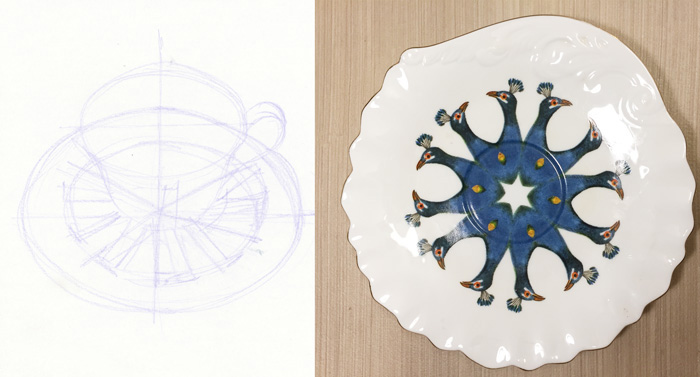
This crazy peacock teacup is lovely to drink from but rather challenging for me to sketch loosely, as it has quite a geometric pattern and the peacock heads ‘require’ a precision that I don’t normally care to attempt. So for this version I spent a little time working out the pattern of the saucer and then set it out using my pencil. Drawing a pencil outline for the overall shape of the saucer also helped with the complicated fluting around the edge – trying to do that freehand and achievng some sort of accuracy with the ellipse is extremely difficult.
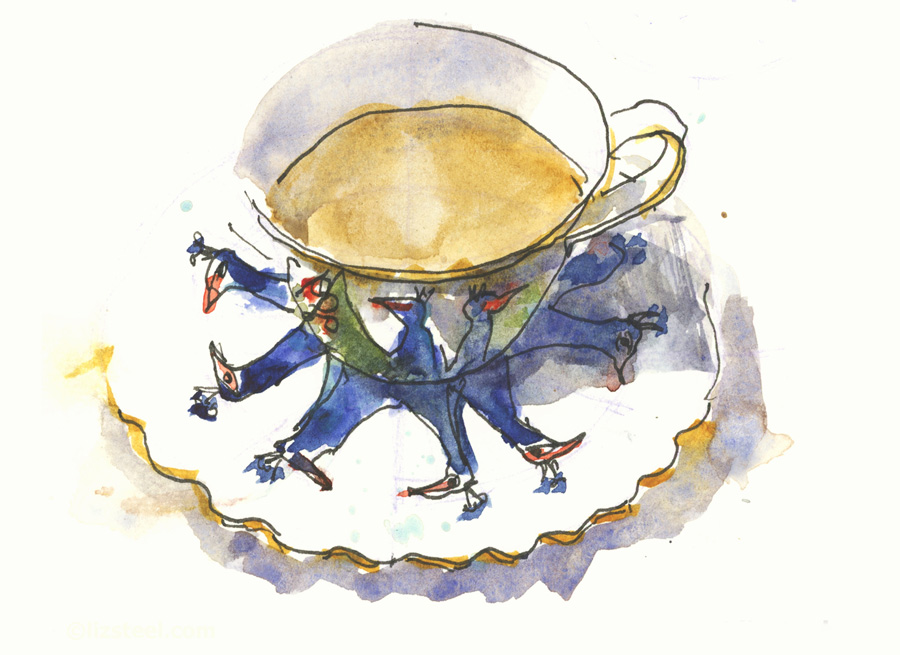
When it came to ink and paint I worked loosely trying to demonstrate that even if something is loose it can still be accurate in terms of the main volumes.
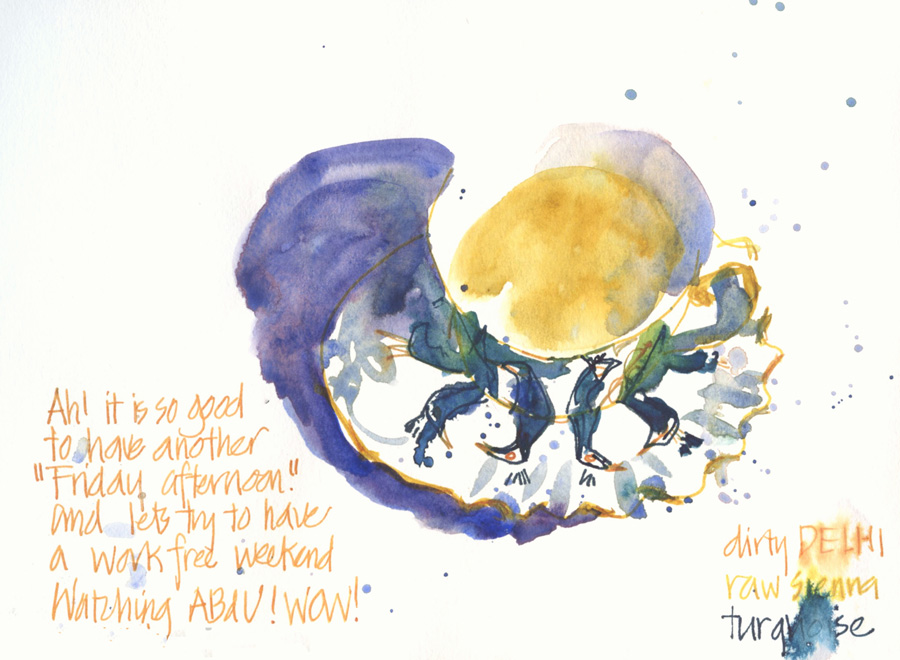
Just for fun, here is a previous sketch of the cup without any pencil guidelines. The positions of the peacocks are not correct but how much does that matter? It is certainly a more lively sketch and I had more fun working spontaneously. However, even though this sketch is loose I was ‘thinking volumes’ while I worked.
2. A tree trunk
You can apply Constructing Volumes to organic objects as well! Chris and I talked a lot about sketching trees in our recent trip to New Zealand, both how to paint the leaves and how to achieve three-dimensionality with the trunks and canopy.

So this week, I was comparing edges, shapes and volumes using a local street tree as my subject.
I hope you can read my notes, for each sketch.
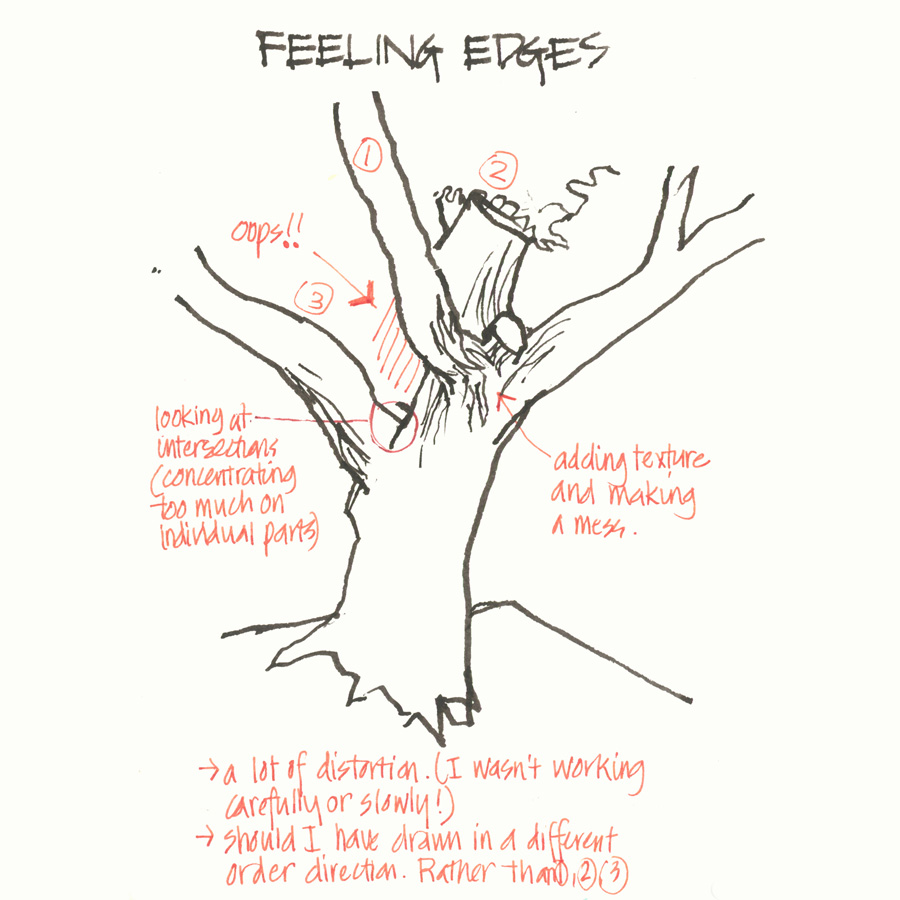
The main takeaways from doing these three versions were:
- When I was feeling edges I was too caught up in the individual intersections and didn’t work slowly enough comparing relationships as I worked.
- When I worked with shapes I had a much better feel for the whole.
- When drawing the volumes, I found myself making a few simplifications, so the careful observation of how the edges intersected really helped me.
I love the way that the three ways of visual thinking work together.
There is a lot more to say about this topic, but that is what the online course is for! If you are working through the lessons at the moment, I would love to know how you are going. The exercise of sketching a stack of overlapping books is a bit tricky, isn’t it?
This is part of a series Foundations Friday where I am revisiting the lessons of my SketchingNow Foundations online class, and exploring the concepts in a new way. To find out more about the course click here.

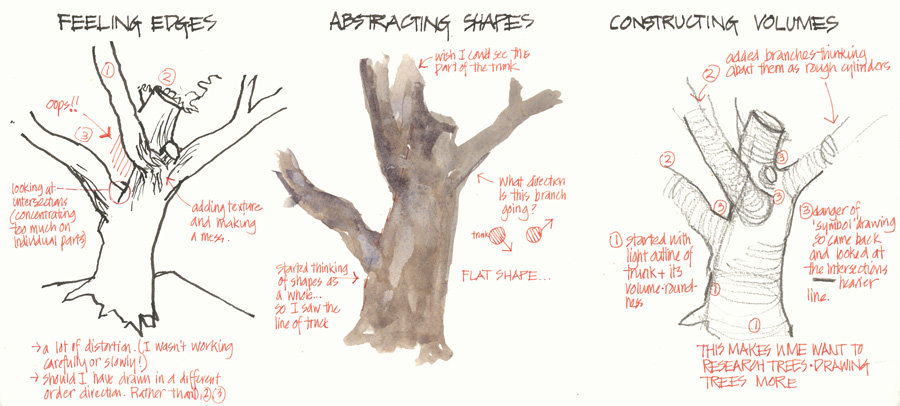
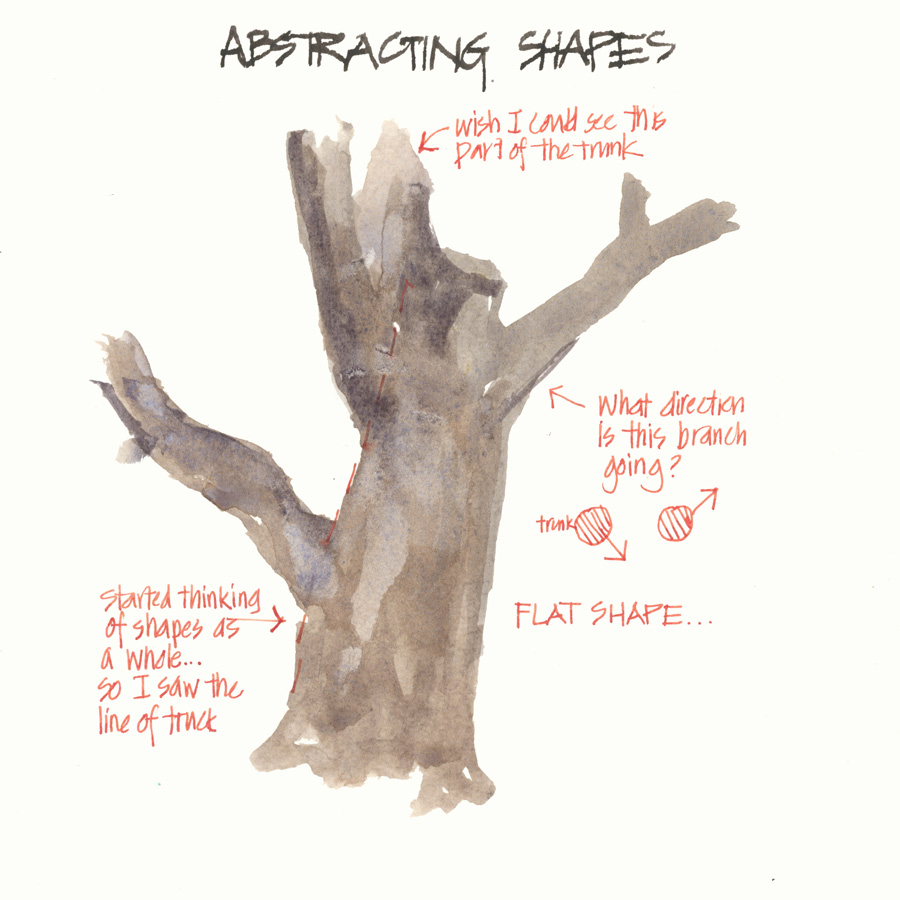
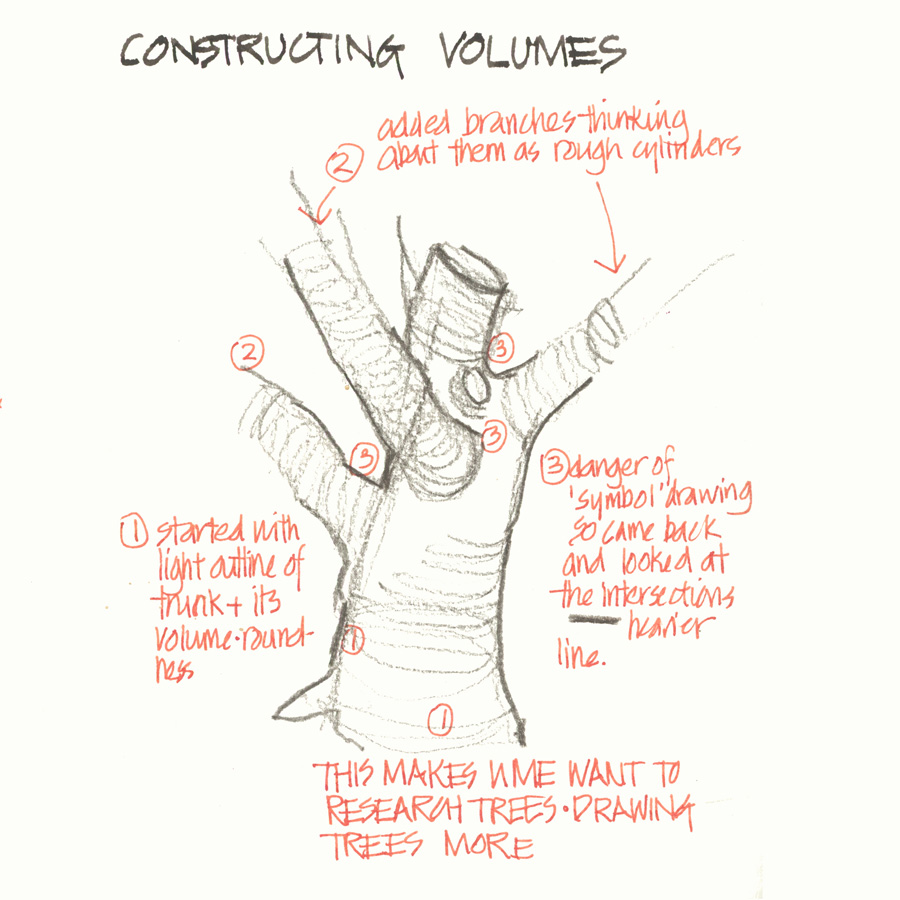



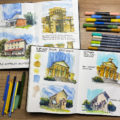
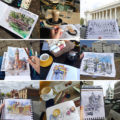
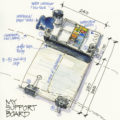
12 Comments
Very helpful! Thank you for the demonstration with the tree.
My pleasure Robin – glad you found it helpful.
I like seeing and reading about your thought process, especially with the tree.
One question for you. When you did the pencils sketch of the teacup at the top were you using a watercolor pencil lines that disappeared into the final painting or were the lines erased? (I guess that’s two questions.)
thanks Jona.
No and no. It was coloured 2mm drafting purple pencil lead (wax) so not water soluble and it was not erased. So the lines are still there. Hope you can see them- especially visible is the thick-ish centre line… and the top left of the saucer where there is no pen
Now that you pointed it out, I do see the line. Thanks for the response. I like knowing how people do things that seem difficult to me like something with such a detailed pattern.
The tree demonstration really helps me understand what you mean by edges and volumes. I’ve been faking a lot of California oaks mostly from the distance, but a few that have been closer could be better if I thought in terms of volume. Thanks, good lesson. Pat
Great to hear Pat!
Indeed, these very simple demos are the most useful for me. Trees without leaves, books with no titles, facade without details… really helps to grasp the concept. Somehow, everything I choose around to draw is either too complicated or too boring ;D Now I see that it is a matter of visual thinking that can make it easier or more interesting. Thanks, Liz.
So glad it was helpful Dulce!
So glad these Foundations Friday’s are still linked to the lesson. This demo of the concepts on two different subjects was helpful in getting the big picture and main stregths of each way of seeing, then putting them all together can bring dramatic advances. Thank you for such rich courses Liz and a depth of resources to help your students really grasp the concepts and put them to use. 🙂
Ditto what Katie said, Liz. The tree demo really helped me understand that the concepts of edges, shapes and volumes are all interrelated, that constructing volumes is not an isolated concept. Wow!
So glad to hear Peggy!
NEWSLETTER
Subscribe for first notification of workshop + online classes and more.